
Lita Albuquerque signs my red jumpsuit, part of Spine of the Earth 2012
At 8:15 Sunday morning I found myself scurrying through a parking lot in Culver City to get on an old-fashioned-looking red and white bus. I took one of the last empty seats alongside dozens of other chipper volunteers as we listened to a group leader tell us about the day ahead of us.
As part of over 300 volunteers for Lita Albuquerque’s performance Spine of the Earth 2012, we had important instructions to follow: there were lines to stand in, forms to sign, red jumpsuits to don, and a big hill to descend—twice.
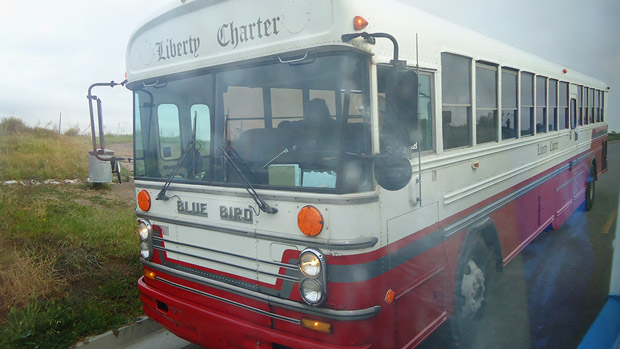
In 1980 Lita Albuquerque staged Spine of the Earth on the dry El Mirage dry lake bed in the Mojave Desert. Circles and lines were traced on the desert floor in red, black, and yellow pigment. The piece, visible in its totality only from above, used the surface of the earth as a drawing plane and emphasized connection with the sky. More than 30 years later, the red pigment would be replaced by humans dressed in red; I was a part of the “spine.”
The bus took us to the top of the Baldwin Hills Scenic Overlook. There I stood in line, chatting with other volunteers and taking in the view. When it was my turn at the table I signed a release form and was given two things—red painter’s coveralls and a red piece of paper with the following prose:
THE LANDSCAPE IS LISTENING
THIS IS SUNDAY, JANUARY 22 OF THE YEAR 2012
CULVER CITY, CALIFORNIA
UNITED STATES OF AMERICA
WESTERN HEMISPHERE
PAY ATTENTION TO THE FEET
YOU EXTEND FROM EARTH TO SKY
RED EARTH
BLUE
FROM INSIDE THE RED
BLUE PLANET
YOU ARE
SURROUNDED IN BLUE
ONE VERTEBRAE IN THE SPINE OF THE EARTH
That missive confirmed for me something I had already suspected when I signed up to participate – that the performance experience was as much about the people in it as it was a spectacle for the audience. Like the people who’d be watching the event, the performers were meant to have their own distinct, possibly transformative, experience of the work. The paper was a set of instructions as important as the choreography we were rehearsing. I had my marching orders: Pay attention.
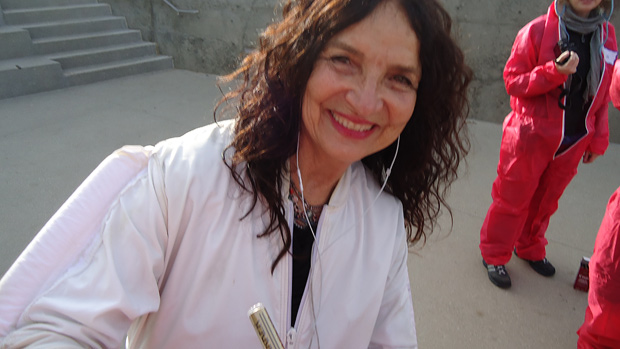
Artist Lita Albuquerque during the preparations for Spine of the Earth 2012
Things were already changing by the time I got to the staging area. On the bus and in line the volunteers were a diverse group of strangers bundled up against the cold in our own clothes. But now, with those (flattering!) red jumpsuits over our clothes, we were all startling to look a little bit alike. We were broken in groups of 15 to 20, so group leaders could go over the movements and timing with us. I was delighted to find that I was in the same group as two of my colleagues, Rani Singh and Lucy Bradnock of the Getty Research Institute, who have been central to the Getty’s Pacific Standard Time exhibitions and events.
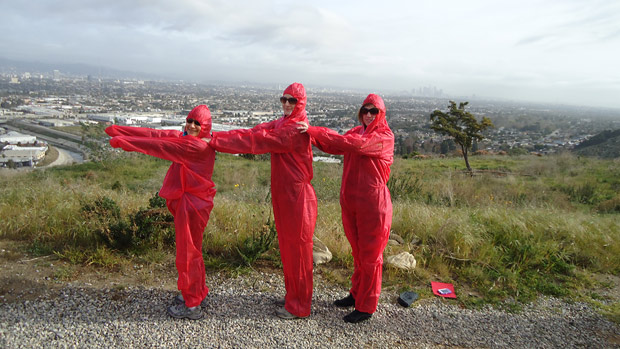
Rani, Lucy, and I in our red jumpsuits, waiting for the performance to begin
After a lot of standing around and photo snapping, we were ready to rehearse. Suddenly, our little group was part of a larger line, slowly stepping toward the top of the 287 steps from the overlook to the base of the trail. Another group of participants walked in a spiral formation with the artist at the lead, then joined our line going down the steps. We walked with our hands on the shoulders of the person in front of us and counted to keep time (“one one thousand, two one thousand…”) trying to keep the line even and unbroken.
Maintaining this pace proved a little challenging on the stairs, which are steep and uneven, and slowly lowering one’s body at each step without breaking formation became the prime objective. Since it was just a rehearsal, I took the liberty of snapping a few pictures while the line was paused on the steps. It was quite a sight, standing in the middle of the staircase, with a cascade of red covered heads and shoulders before me, winding out of the landscape toward civilization below.
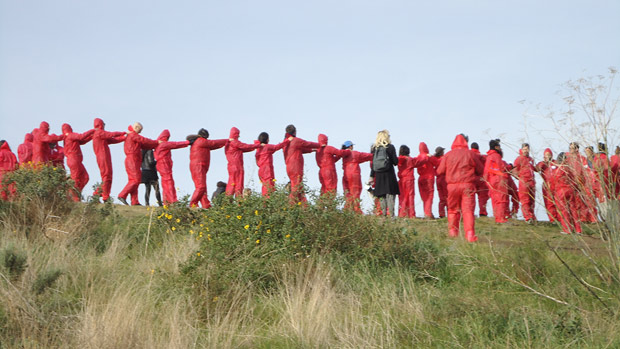
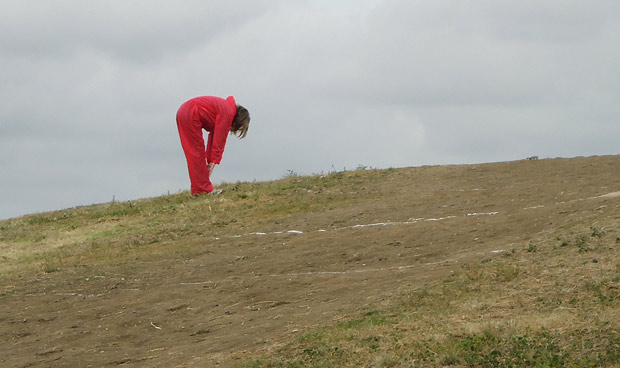
After rehearsal we broke for lunch, and I ran into a few more colleagues and friends, some in red and some just there to watch. You could sense the excitement as people buzzed around talking about how they came to be there that day, or what other events they would see as part of the Pacific Standard Time Performance and Public Art Festival.
Now we gathered for the real performance, which would take longer than the rehearsal. We heard our last set of instructions, put up our red hoods, and stood in line watching the sky for the sky diver who would be our signal to start. As we waited, Ms. Albuquerque read the words that were handed out earlier to a silent crowd via walkie talkies, reminding us to “pay attention to the feet.”
The plane started circling, and at a few minutes after noon she jumped! Clad in her own red jumpsuit, skydiver Anne Helliwell glided down, red smoke trailing behind her, and perfectly hit her mark, a plume of red smoke in the center of a ring of participants at the top of the overlook. It was a thrilling spectacle and after a few moments of raucous cheers the skydiver took her place at the back of the line and we started the slow procession down the hill.
Now it seemed easier to find our pace and it only took a few seconds of steady stepping for the counting, “one one thousand, two one thousand,” to begin to feel like chanting. This time there was no craning our heads to look, no stopping for pictures; we kept our heads down and focused on staying evenly in line.
My view was mainly the shrubbery around us, the stone and mud steps below us and a sea of red in front of me, though occasionally I had a fleeting glimpse of the crowd of spectators watching from below and the city sprawled out beyond them. When the front of the line reached the bottom step, we stopped. In a slow, steady wave we raised our arms for about four seconds and then lowered them. We stood there in silence for a few minutes, and the sound of steady counting was replaced by beat of the helicopter circling overheard.
As I stood there quietly, the bushes rustling in a mild breeze and the steady breathing of 300 quiet people barely audible to me, I tried to imagine what it looked like from the helicopter above. That’s when I really found meaning in the piece. I realized that I couldn’t see the big picture, but that I was an integral part of it. That no matter one’s place in line, if we stay connected to the people and places around us, every now and then it’s possible to stop and imagine a bigger picture and our link to it.
After this illuminating pause, we continued down the hill, until everyone in the line had wound their way down the stairs and around a bend to an out-of-sight spot. There we shed the red and returned to being regular people.
As I made my way down the trail to my family, I decided I needed to come back to that place soon. Maybe I’ll even take few minutes to stand again in that same spot on the stairs, enjoying the view and paying attention to the world around me and my role in it.
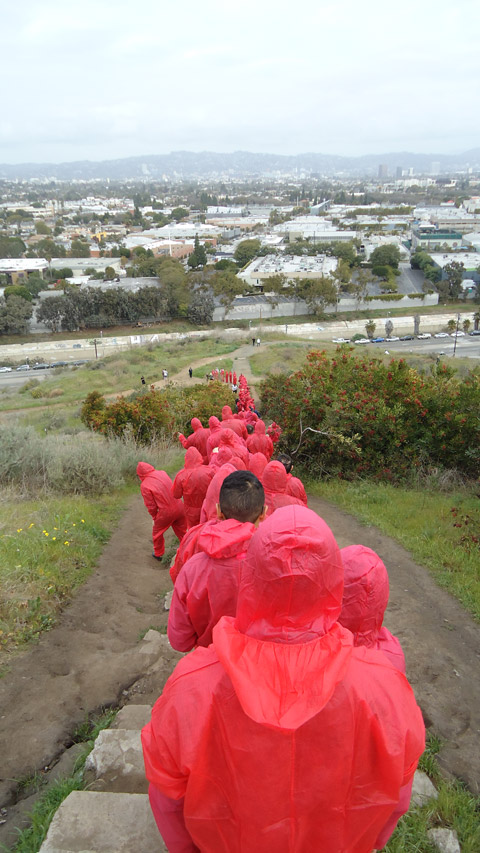



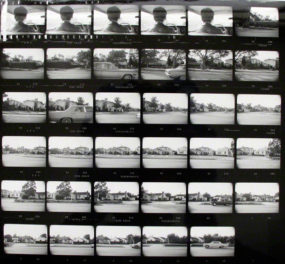
Would like to see a photograph from above. Googled same unable to find. Can anyone let me know where to find. Always come back to blog.
Hi Neil, In fact, aerial photographs were taken. They’re not online yet, but will be soon. I’ll be sure to post a link as soon as they are. In the meantime, you can see photos and videos from the performance here: http://pacificstandardtimefestival.org/events/spine-of-the-earth-2012-by-lita-albuquerque/
–Amy